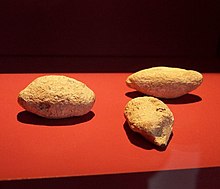Tony Clunn
John Anthony Spencer Clunn
Army career
Born in Kent, Clunn served in the ranks of the
Archaeology

Clunn searched for Roman coins with a metal detector as a hobby. In 1987, when he was attached to the Royal Tank Regiment in Osnabrück, he asked Wolfgang Schlüter, at the time the archaeologist for the District of Osnabrück,[8] where he should look.[9] He was advised to search 20 km north of the city, where Roman coins had previously been found,[10] though none for 18 years.
Schlüter's recommendation was based upon a study of maps and the 19th-century historian Theodor Mommsen's proposal that the Kalkriese area was a likely location of the battle which took place in 9 C.E.[11] On his first day, Clunn found several coins from the reign of Augustus, mostly in excellent condition.[9] No coins found at the site post-date 9 C.E.[12] He also discovered Roman sling shot in the vicinity of Kalkriese,[9] the first indisputable evidence of military activity there.[12][13] Previously there had been many conflicting theories about the location of the battle, and scholars had searched for it without success for 600 years.[10][14][15][16]
On the basis of Clunn's findings, Schlüter began a comprehensive excavation of the site in 1989,
Retirement
Clunn returned to Osnabrück to live.[18] He was awarded the Cross of the Federal Republic of Germany. He died on 3 August 2014 at his home in Bissendorf.[19]
Publications
- Tony Clunn. Ed. Anna Cheeseman-Clunn and Ursula Cheeseman. In Quest of the Lost Legions: The Varusschlacht. London: Minerva, 1999. ISBN 0-7541-1068-0
- Tony Clunn. The Quest for the Lost Roman Legions. Spellmount: Savas Beatie, 2005. ISBN 978-0-9544190-0-4
References
- ^ "No. 50420". The London Gazette (Supplement). 3 February 1986. p. 1625.
- ^ "No. 51194". The London Gazette (Supplement). 11 January 1988. p. 306.
- ^ "No. 53807". The London Gazette (Supplement). 3 October 1994. p. 13871.
- ^ "No. 54255". The London Gazette (Supplement). 29 December 1995. p. 6.
- ^ "The New Year Honours: The Prime Minister's List", The Independent 30 December 1995.
- ^ "No. 54378". The London Gazette (Supplement). 22 April 1996. p. 5716.
- ^ Wolfgang Schlüter: Zwischen Lutherdamm und Oberesch – Die Anfänge des Kalkriese-Projektes. In: Varus-Gesellschaft (Hrsg.): Varus-Kurier. Georgsmarienhütte, April 2002. S. 7ff. (in German)
- ^ a b Archäologie, Ausgrabung und Wissenschaft Archived 29 April 2015 at the Wayback Machine, Museum und Park Kalkriese, retrieved 7 September 2010. (in German)
- ^ a b c d e Fergus M. Bordewich, "The Ambush that Changed History", Smithsonian September 2005, pp. 3,–4.
- ^ ISBN 0-393-02028-2, p. 46.
- ^ Theodor Mommsen, "Die Örtlichkeit der Varusschlacht", Berlin: Weidmann, 1885. (in German)
- ^ a b c d David Crossland, "Battle of the Teutoburg Forest: Germany Recalls Myth That Created the Nation", Der Spiegel 28 August 2009.
- ISBN 3-922469-76-0, p. 20. (in German)
- ^ "Fiasko in der Senke: Rekonstruktion der Varus-Schlacht auf der Basis der neuesten Grabungsfunde", Der Spiegel 28 October 1996. (in German)
- ^ Kevin Sweeney, "Scholars look at factors surrounding Hermann’s victory" Archived 14 July 2011 at the Wayback Machine, The Journal, New Ulm, Minnesota, 20 September 2009, retrieved 7 September 2010.
- ISBN 1-85109-730-9, p. 307.
- ISBN 0-7541-1068-0, p. 154.
- ^ "Society for German-American Studies Symposium Held in Grand Rapids, MI", Steuben News, July/August 2005 Archived 28 July 2011 at the Wayback Machine, retrieved 7 September 2010. Clunn was the keynote speaker.
- ^ "Varusschlacht-Pionier Tony Clunn verstorben", NDR, 7 August 2014 (in German)
Sources
- The Lost Legions of Varus. Television movie. Granada Television, 2001. ImdB
- Wolfgang Schlüter. "Kalkriese: Ort der Varusschlacht. Die Ausgrabungen in der Kalkrieser-Niederwedder Senke". Archäologische Mitteilungen aus Nordwestdeutschland Beiheft 9 (1994). (in German)
